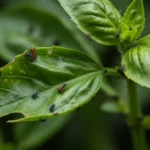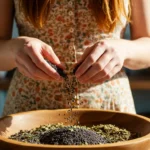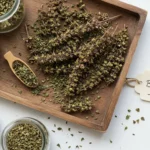Eight years ago, knee-deep in soil, I, Kalsoom Imran, watched in disbelief as my usually thriving basil looked utterly miserable next to a seemingly happy cilantro plant. It sparked a question that’s plagued many gardeners since: can you plant basil and cilantro together?
Understanding Basil and Cilantro
Basil: A Warm-Weather Favorite
Oh, basil. Just the thought of its fragrant leaves makes me want to whip up a fresh pesto or a Caprese salad. This herb is a true sun-lover, thriving in warm conditions and absolutely hating the cold. I’ve always found that basil is happiest when the temperatures are consistently above 60°F (15°C), and it really takes off when it gets a good dose of sunshine.
It’s one of those plants that just seems to soak up the light and turn it into vibrant, aromatic foliage. I’ve tried growing it in shadier spots, and it just doesn’t have the same zest. It’s definitely a warm-weather champion in my book, and I always look forward to planting it when the threat of frost has passed.

Cilantro: A Cool-Weather Herb
Now, cilantro is a completely different story. Unlike its sun-worshipping counterpart, cilantro prefers cooler temperatures. It’s one of those herbs that bolts, or goes to seed, quickly when it gets too hot. I’ve learned this the hard way, watching my cilantro plants suddenly shoot up and turn bitter when the summer heat hits.
I find that cilantro grows best in the spring and fall, when the weather is mild. It can tolerate some shade, which is a nice bonus if you don’t have a full-sun garden. It’s a delicate herb and definitely requires a different approach than the robust basil. Companion planting basil cilantro needs careful consideration, and understanding these differences is key.
The Question: Can Basil and Cilantro Be Planted Together?
Are Basil and Cilantro Compatible?
This is the question that’s been on my mind for a while now. Can these two very different herbs, with their distinct preferences, actually coexist in the same garden space? It’s not as simple as just sticking them in the ground and hoping for the best. The truth is, their contrasting needs might create some challenges. Are basil and cilantro compatible? That’s a question we need to explore further. I’ve been pondering this for a while now, and I’m eager to see what the best approach is.

Do Basil and Cilantro Grow Well Together?
The short answer is: it’s complicated. While they aren’t natural enemies, their drastically different needs can make it tricky to get them both to thrive when planted side-by-side. Do basil and cilantro grow well together? Not always. Basil wants warmth and sun, while cilantro prefers cooler temperatures and some shade. This difference can lead to one herb outcompeting the other, or both struggling to reach their full potential. It’s definitely something to consider before you decide to plant them together.
Potential Challenges of Growing Basil and Cilantro Together
Different Growing Needs: Sunlight and Temperature
The biggest hurdle when trying to grow basil and cilantro together is their opposing preferences for sunlight and temperature. Basil needs a lot of direct sunlight to flourish, while cilantro can get stressed and bolt in too much heat. This means that if you plant them together in a spot that’s ideal for basil, the cilantro might struggle.
Conversely, if you choose a spot that’s better for cilantro, the basil might not get enough sun. This difference in needs is the main reason why growing basil and cilantro together can be tricky.

Watering Requirements: Basil vs. Cilantro
Another challenge is their different watering needs. Basil prefers consistently moist soil, but it doesn’t like to be waterlogged. Cilantro, on the other hand, prefers drier conditions and can be susceptible to root rot if it’s overwatered. This means that if you water them both the same way, one or both might not be happy. It’s crucial to understand these differences when considering planting basil with cilantro.
Will Basil and Cilantro Compete?
Yes, they can compete. Basil is a more robust plant, and if it’s thriving, it can easily overshadow and outcompete the more delicate cilantro, depriving it of sunlight and nutrients. This can lead to the cilantro becoming leggy and weak, or even failing to thrive altogether. So, yes, will basil and cilantro compete? Absolutely. This is a key concern when planning your garden.
Timing Issues: Planting Basil with Cilantro
Timing is also crucial. Basil is typically planted after the last frost, when the weather has warmed up, while cilantro is best planted in the cooler months of spring and fall. This means that if you try to plant them together at the same time, one or both might not be planted at the ideal time for its growth. This is another reason why planting basil with cilantro requires careful consideration of timing.
Can You Grow Basil and Cilantro in the Same Container?
Cilantro and Basil in Same Pot: Is it Possible?
Technically, yes, it’s possible to grow cilantro and basil in the same pot, but it’s not ideal. Given their differing needs, one or both are likely to suffer. You’d have to be very careful about watering and placement, and even then, success isn’t guaranteed. Cilantro and basil in the same pot is a challenge, and you need to be aware of the potential problems.
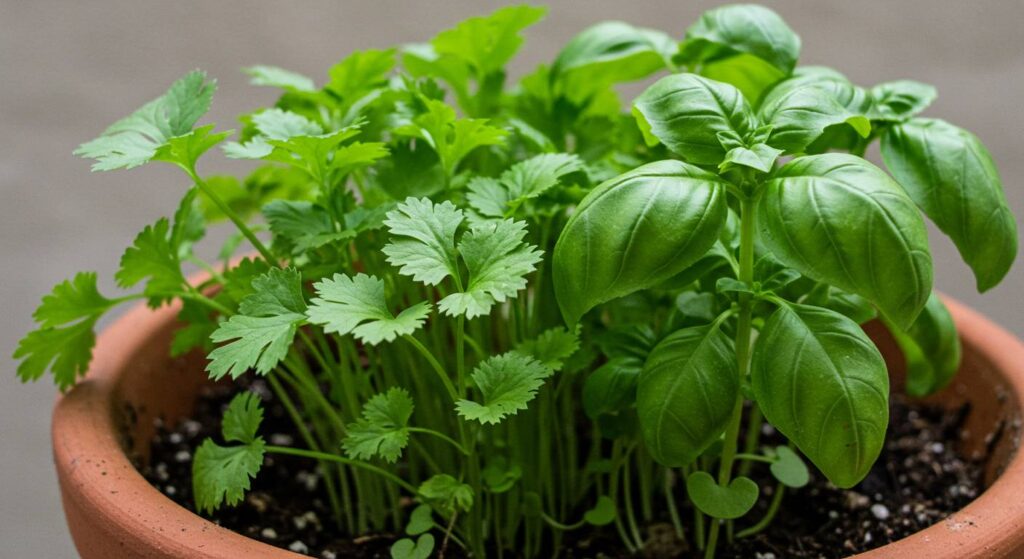
Can You Grow Basil and Cilantro in the Same Container: Considerations
If you do decide to try growing basil and cilantro in the same container, you need to be very mindful of their needs. Choose a large pot to give them enough space, and make sure the pot has good drainage. You’ll also need to be very careful about watering, trying to keep the soil moist for the basil without overwatering the cilantro. It’s a balancing act, and it requires a lot of attention. The question of can you grow basil and cilantro in the same container really comes down to your willingness to manage their conflicting needs.
Mixing Basil and Cilantro in Garden
While putting them in the same pot is tricky, mixing them in the garden can be just as challenging. The same issues of differing sunlight, temperature, and watering needs apply. It’s not impossible, but it requires careful planning and management. Mixing basil and cilantro in garden is something that needs to be approached cautiously.
Successful Basil and Cilantro Planting: Tips and Tricks
Choosing the Right Location: Garden Planning Basil and Cilantro
The key to success when growing basil and cilantro is to carefully choose the right location. If you’re planting them in the garden, try to find a spot that gets morning sun, which will be suitable for both. The afternoon sun can be too intense for cilantro. If you’re growing them in containers, you can move them around to provide the best conditions for each. Garden planning basil and cilantro is crucial to ensure both thrive.
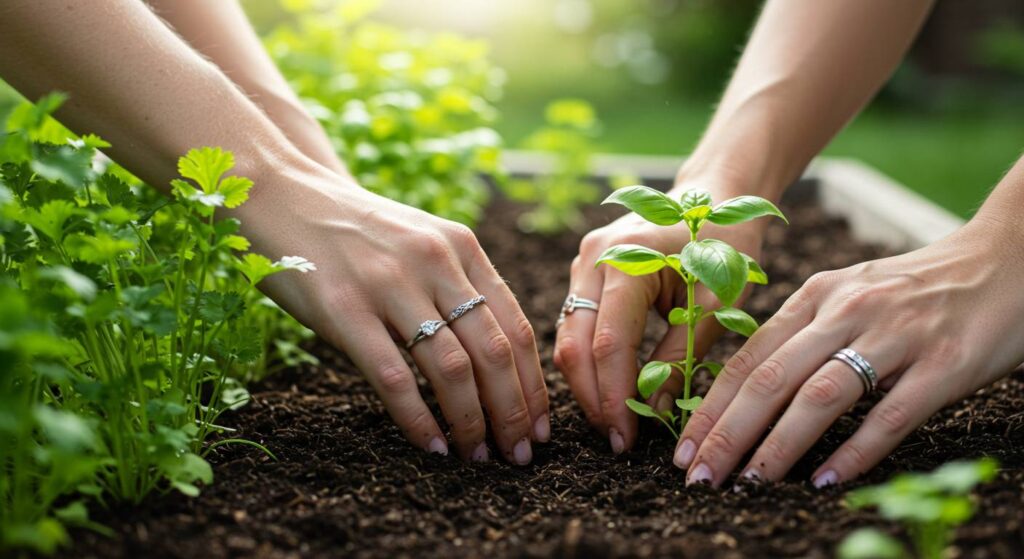
Soil Preparation for Basil and Cilantro
Both basil and cilantro prefer well-draining soil. Amend your soil with compost or other organic matter to improve drainage and fertility. This will help both plants establish healthy roots. Proper soil preparation is essential for successful basil and cilantro planting.
Watering and Maintenance: Basil Cilantro Growing Tips
Water basil regularly to keep the soil consistently moist, but don’t overwater. Cilantro prefers drier conditions, so water it less frequently. Monitor both plants closely and adjust your watering schedule as needed. Basil cilantro growing tips often revolve around careful watering practices.
Planting Herbs Together Basil Cilantro: Spacing is Key
When planting basil and cilantro together, make sure to space them adequately. This will help reduce competition for resources and prevent one plant from overshadowing the other. Providing enough space is crucial when planting herbs together basil cilantro.
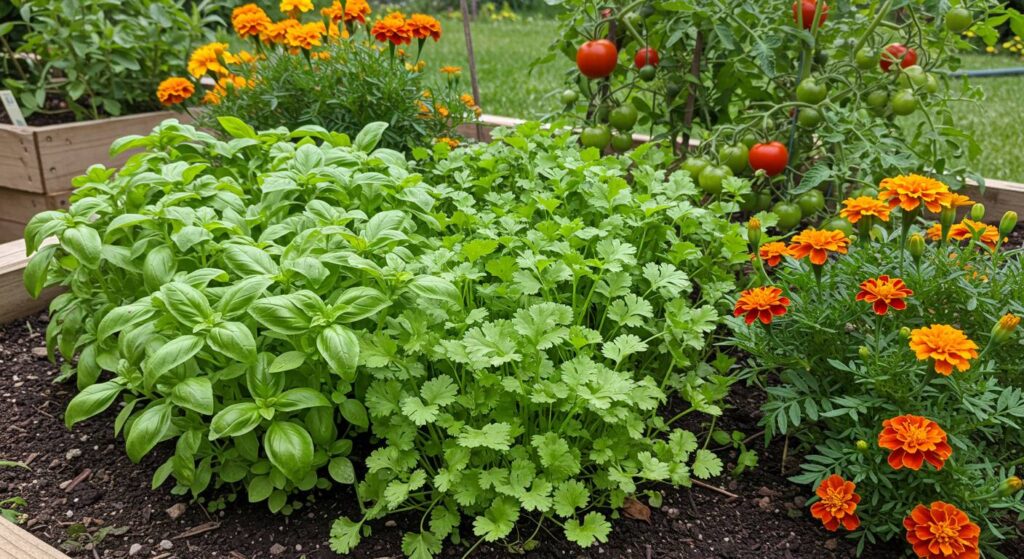
Companion Planting Basil Cilantro: Best Practices
Suitable Companions for Basil and Cilantro
While basil and cilantro might not be the best companions for each other, they do have other plants that they grow well with. Basil, for example, is a great companion for tomatoes, peppers, and other nightshades. Cilantro, on the other hand, does well with carrots, onions, and other cool-season crops. Knowing suitable companions for basil and cilantro can help you plan your garden more effectively.
Good Companions for Cilantro and Basil
Some of the best companions for cilantro include dill, parsley, and other cool-season herbs and vegetables. For basil, good companions include tomatoes, peppers, and oregano. These pairings can create a more balanced and thriving garden ecosystem. Knowing good companions for cilantro and basil can help you optimize your garden space.
Compatible Herbs with Basil and Cilantro
When considering compatible herbs with basil and cilantro, it’s best to focus on herbs with similar needs. For basil, herbs like oregano, thyme, and rosemary are good options. For cilantro, parsley, dill, and chervil are good choices. These pairings can help you create a more harmonious garden.
Planting Herbs Next to Each Other Basil Cilantro
When planting herbs next to each other basil cilantro, it’s important to consider their individual needs. While it might be tempting to plant them close together, it’s often better to give them some space and choose companions that are more compatible. This will help ensure that all of your herbs thrive.
Alternative Plant Pairing Basil Cilantro
Basil and Cilantro Garden Pairing: Exploring Options
Instead of trying to force basil and cilantro to grow together, it might be better to explore alternative plant pairings. This could mean planting them in different parts of the garden or choosing other herbs that are more compatible with each. Basil and cilantro garden pairing requires careful consideration of each plant’s needs.
Best Plants to Grow with Basil and Cilantro
As mentioned earlier, tomatoes, peppers, and oregano are great companions for basil, while carrots, onions, and dill are good for cilantro. By focusing on these pairings, you can create a more thriving and productive garden. Identifying the best plants to grow with basil and cilantro can make a big difference in your garden’s success.
Plant Pairing Basil Cilantro: Alternatives
When it comes to plant pairing basil cilantro, it’s often better to think of alternatives. Instead of trying to force them to grow together, consider planting them in different areas of the garden with more compatible companions. This will help ensure that both herbs reach their full potential.
Are Basil and Cilantro Compatible: A Final Verdict
Is It Okay to Plant Basil and Cilantro Together?
While it’s technically possible to plant basil and cilantro together, it’s not ideal. Their differing needs for sunlight, temperature, and water make it challenging to get them both to thrive. So, is it okay to plant basil and cilantro together? It’s not recommended for beginners, and even experienced gardeners may find it difficult.
Growing Herbs Side by Side Basil Cilantro: Key Takeaways
The key takeaway here is that while you can try to grow basil and cilantro side by side, it requires a lot of attention and careful management. It’s often better to plant them separately and choose more compatible companions for each. Growing herbs side by side basil cilantro requires a good understanding of each plant’s needs.
Successful Basil and Cilantro Planting: What You Need to Know
To achieve successful basil and cilantro planting, you need to understand their individual needs, choose the right location, prepare the soil properly, and water them carefully. It’s also important to consider companion planting and choose more compatible pairings.
How to Grow Basil and Cilantro Together: A Recap
Can I Plant Cilantro Near Basil?
While you can try, it’s not the most ideal pairing. Cilantro prefers cooler conditions and some shade, while basil thrives in warm, sunny spots. So, can I plant cilantro near basil? It’s possible, but it requires careful management.
Can I Put Basil and Cilantro in the Same Garden Bed?
Yes, you can, but it’s not the best approach. Their differing needs can make it difficult for both plants to thrive. It’s often better to plant them in different areas of the garden with more suitable companions. So, can I put basil and cilantro in the same garden bed? It’s a challenge, and you need to be prepared for potential difficulties.
Can You Grow Basil and Cilantro in the Same Container?
Yes, it’s possible, but it’s not recommended. Their conflicting needs for water and sunlight can make it difficult to keep both plants healthy. Can you grow basil and cilantro in the same container? Yes, but it’s not the most practical approach.


